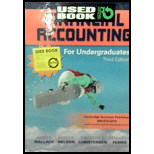
1)
Calculate the return on sales ratio for each year and comment on Company L’s profitability.
1)
Explanation of Solution
Return on sales ratio: The ratio which evaluates the amount of net income earned for every dollar of net sales is referred to as return on sales ratio. Higher ratio indicates highly profitable company.
Compute the return on sales ratio for Company L for the year 2013.
Net income = ($228) million
Net sales = $2,099 million
There is a net loss of $(228). If, there is any net loss in a particular year then the calculation on the return on sales ratio becomes irrelevant.
Compute the return on sales ratio for Company L for the year 2014.
Net income = $74 million
Net sales = $2,128 million
Comments:
- Profitability of Company L is measured by return on sales ratio.
- The ratio is 3.4% in 2014.
- This shows that the company’s profitability has increased.
2.
Calculate the
2.
Explanation of Solution
Current ratio: Current ratio is one of the liquidity ratios, which measures the capacity of the company to meet its short-term obligations using its current assets. The ideal current ratio is 2:1. The following formula is used to calculate current ratio.
Compute current ratio for Company L for the year 2013.
Current assets = $847 million
Current liabilities = $462 million
Compute current ratio for Company L for the year 2014.
Current assets = $933 million
Current liabilities = $455 million
Comments:
- Liquidity of Company L is evaluated by current ratio.
- The ratio shows an increasing trend from 1.83 in 2013 to 2.05 in 2014.
- This shows that the capacity to pay for short-term liabilities has increased.
3.
Calculate the debt-to-total-assets ratio for each year and comment on Company L’s solvency.
3.
Explanation of Solution
Debt to Asset Ratio: Debt to asset ratio is the ratio between total asset and total liability of the company. Debt ratio reflects the finance strategy of the company. It is used to evaluate company’s ability to pay its debts. Higher debt ratio implies the higher financial risk.
Compute debt-to-total assets ratio for Company L for the year 2013.
Total assets = $1,382 million
Total liabilities = $660 million
Compute debt-to-total assets ratio for Company L for the year 2014.
Total assets = $1,451 million
Total liabilities = $647 million
Comments:
- Liquidity of Company L is measured by debt-to-total assets ratio.
- The ratio shows a decreasing trend from 47.75% in 2013 to 44.58% in 2014.
- This shows that the repaying capacity of the corporation has increased.
4.
Calculate the free cash flows for each year and comment on free cash flows of Company L.
4.
Explanation of Solution
| Particulars | 2013 | 2014 |
| Free cash flows: | ($ in million) | |
| Cash flow from operating activities | $122 | $205 |
| Less: Cash investment in property, plant and equipment | 54 | 47 |
| Free cash flow | $68 | $88 |
Table (1)
Comments:
- The ratio shows a decreasing trend from $68 in 2013 to $88 in 2014.
- But Company L had a healthy free cash flow in the years to repay its lenders, pay dividends to stockholders.
5.
Explain the way of two different fiscal year endings that affect the comparison of Incorporation A and Company L’s financial results.
5.
Explanation of Solution
Comparing ratios of Company L with Incorporation A’s ratios:
| Ratios | Company L | Incorporation A | ||
| 2013 | 2014 | 2013 | 2014 | |
| Return on sales ratio | NA | 3.4% | 21.7% | 21.6% |
| Current ratio | 1.83:1 | 2.05:1 | 1.68:1 | 1.08:1 |
| Debt-to-total assets ratio | 47.75% | 44.58% | 40.3% | 51.9% |
| Free cash flow | $68 | $88 | $45,501 | $50,142 |
Table (2)
Note:
- Refer to the requirements 1-4 for the values and calculations of the ratios furnished above for Company L.
- Refer to the Exhibits-4.6, 4.7, 4.8, and page number 194 of the text book for the values and calculations of the ratios furnished above for Incorporation A.
The effect of financial results of Company L and Incorporation A due to different fiscal year-ends:
- As the Incorporation A’s fiscal year end is September and Company L’s fiscal year-end is March, the available financial data would be more for Incorporation A (January to September) and Company L (January to March).
- The benchmarking process would be difficult due to volume of financial data.
- As the fiscal year ends are different the sales volume also depends on the number of months in the fiscal year. Therefore, the return on sales ratio for Incorporation A is more than the L International.
Want to see more full solutions like this?
Chapter 4 Solutions
FINANCIAL ACCT.F/UNDERGRADS-W/ACCESS

 AccountingAccountingISBN:9781337272094Author:WARREN, Carl S., Reeve, James M., Duchac, Jonathan E.Publisher:Cengage Learning,
AccountingAccountingISBN:9781337272094Author:WARREN, Carl S., Reeve, James M., Duchac, Jonathan E.Publisher:Cengage Learning, Accounting Information SystemsAccountingISBN:9781337619202Author:Hall, James A.Publisher:Cengage Learning,
Accounting Information SystemsAccountingISBN:9781337619202Author:Hall, James A.Publisher:Cengage Learning, Horngren's Cost Accounting: A Managerial Emphasis...AccountingISBN:9780134475585Author:Srikant M. Datar, Madhav V. RajanPublisher:PEARSON
Horngren's Cost Accounting: A Managerial Emphasis...AccountingISBN:9780134475585Author:Srikant M. Datar, Madhav V. RajanPublisher:PEARSON Intermediate AccountingAccountingISBN:9781259722660Author:J. David Spiceland, Mark W. Nelson, Wayne M ThomasPublisher:McGraw-Hill Education
Intermediate AccountingAccountingISBN:9781259722660Author:J. David Spiceland, Mark W. Nelson, Wayne M ThomasPublisher:McGraw-Hill Education Financial and Managerial AccountingAccountingISBN:9781259726705Author:John J Wild, Ken W. Shaw, Barbara Chiappetta Fundamental Accounting PrinciplesPublisher:McGraw-Hill Education
Financial and Managerial AccountingAccountingISBN:9781259726705Author:John J Wild, Ken W. Shaw, Barbara Chiappetta Fundamental Accounting PrinciplesPublisher:McGraw-Hill Education





